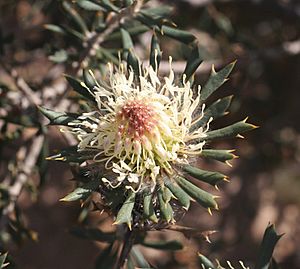Pink dryandra facts for kids
Quick facts for kids Pink dryandra |
|
|---|---|
 |
|
| Banksia carlinoides near Hill River | |
| Scientific classification | |
| Genus: |
Banksia
|
| Species: |
carlinoides
|
| Synonyms | |
|
|

The Pink Dryandra (scientific name: Banksia carlinoides) is a type of shrub that grows only in Western Australia. It has long, narrow leaves that are shaped like an egg or a wedge. These leaves have a few sharp, pointed edges. The plant produces groups of creamy white flowers, which often have a pink tint. Each group can have up to one hundred flowers.
Contents
What the Pink Dryandra Looks Like
The Pink Dryandra is a round, bushy shrub. It usually grows to about 1.3 meters (about 4 feet) tall. Unlike some other plants, it does not have a special woody base called a lignotuber that helps it regrow after a fire.
Its leaves are narrow and can be shaped like an egg or a wedge. They are about 11 to 35 millimeters long and 3 to 9 millimeters wide. Each leaf sits on a short stalk called a petiole, which is about 1 to 2 millimeters long. The upper part of the leaf has up to four sharp teeth on each side, which can be up to 3 millimeters long.
The flowers grow in clusters at the ends of the stems. Each cluster has between 75 and 100 flowers. These clusters are surrounded by special leaves called involucral bracts, which are up to 13 millimeters long. The flowers are creamy white and often have a pink color. The main part of the flower (the perianth) is about 10 to 20 millimeters long. The female part of the flower (the pistil) is about 16 to 23 millimeters long.
Flowering and Fruit
The Pink Dryandra usually blooms from September to October. After flowering, it produces fruits called follicles. These fruits are shaped like an ellipse or an egg and are about 8 to 11 millimeters long.
How it Got its Name
This plant was first officially described in 1848 by a scientist named Carl Meissner. He gave it the name Dryandra carlinoides. He published his description in a book called Plantae Preissianae.
The second part of its name, carlinoides, means "like Carlina". This is because Meissner thought the plant looked similar to other plants in the genus Carlina.
Later, in 2007, two other scientists, Austin Mast and Kevin Thiele, moved all the plants from the genus Dryandra into the genus Banksia. This is why its full scientific name is now Banksia carlinoides.
Where it Grows
The Pink Dryandra grows in a type of low shrubland called kwongan. It is found in many places across Western Australia. You can find it in the area between Geraldton, Gingin, and Piawaning.
See also
 In Spanish: Dryandra carlinoides para niños
In Spanish: Dryandra carlinoides para niños

